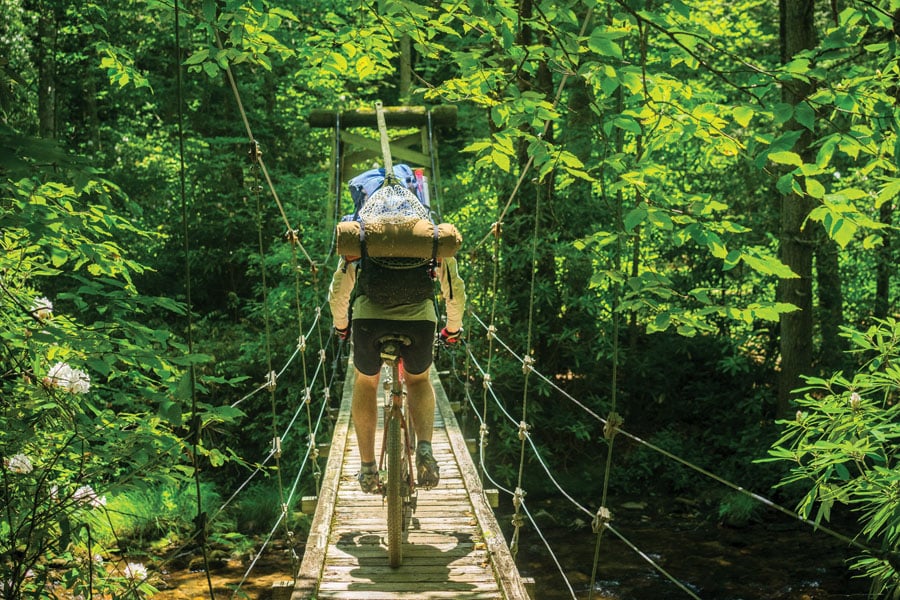The Pisgah National Forest sprawls across some 500,000 acres of Western North Carolina woods and waters, and it’s especially renowned for two activities: mountain biking and fly fishing. The singletrack that criss crosses this temperate rainforest beckons mountain bikers from all over the country, and some from beyond its borders, and its trout streams have long been etched in the annals of America’s fly fishing folklore. So in my mind, it stood to reason that a multi-day adventure combining the two pursuits would be nothing short of pure Pisgah gold.
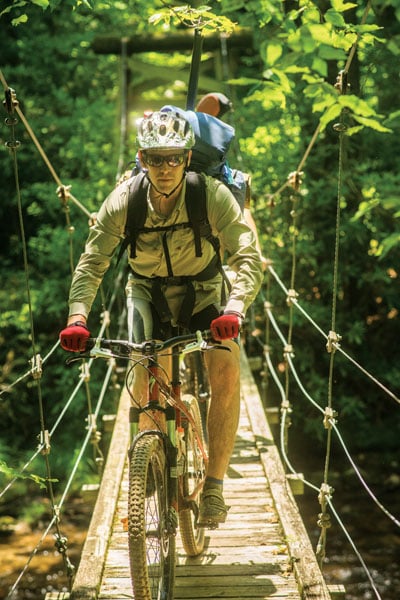
When my budding idea for a “bikefishing” excursion that would incorporate both Pisgah’s famed trout streams and its world-renowned single track began to take shape, I was told there was one person that I needed to talk to. Enter fly fishing guide and guru Aaron Motley of Hunter Banks Fly Fishing in Asheville and Waynesville, N.C.
A Clemson, S.C. native and an exceptional mountain biker, Motley was one of the first members of the now highly-accomplished Brevard College Mountain Biking Team. He routinely uses his hardtail to gain access to wilder and more remote stretches of water that would otherwise require miles of arduous hiking. When we began plotting our adventure, he immediately recommended Pisgah’s South Mills River.
Thanks to some helpful consultation with Steve Yocom, the photographer who would eventually join us on the trip, and Blue Ridge Outdoors Digital Publisher/walking Pisgah map Dusty Allison, the South Mills was already on my short list of go-to bikefishing destinations. But Aaron’s exuberance and his encyclopedic knowledge of the South Mills drainage—helped along by a few photos of sizable wild trout he’d netted on a previous trip to the area—completely sealed the deal.
The South Mills
The South Mills River area encompasses approximately 17,120 acres of the Pisgah National Forest— 8,629 of which are considered roadless acres.
It is bordered by the spine of the Blue Ridge Mountains on its northern end and the South Mills drainage basin to the south, while the congressionally-designated Cradle of Forestry forms its western boundary.
Once a part of railroad heir George Vanderbilt’s expansive private forest, which shared a name with his now world famous Asheville estate, this portion of Pisgah played a pivotal role in the early forest management and conservation legacy of the United States.
In the late 1800s, Vanderbilt hired a young forester named Gifford Pinchot to manage the vast and growing woodland holdings on his enormous Biltmore Estate. Though Pinchot would only serve a brief tenure at Biltmore before taking a job in Washington, D.C. as the first chief of Teddy Roosevelt’s newly established United States Forest Service, his time there laid the groundwork for the nation’s first forestry school. The remnants of this school, which was deconstructed and moved to the nearby Cradle of Forestry in the 1970s, can still be seen along the banks of Cantrell Creek in the South Mills area.
In 1988, the state of North Carolina awarded the South Mills an Outstanding Resource Waters designation, and by 1990 Congress had listed it as a National Wild and Scenic Study River. In ‘96, the USFS followed suit, determining that several sections of the river are indeed worthy of full-on Wild and Scenic classification. If that level of protection ever comes to fruition, the South Mills will become North Carolina’s longest wild river.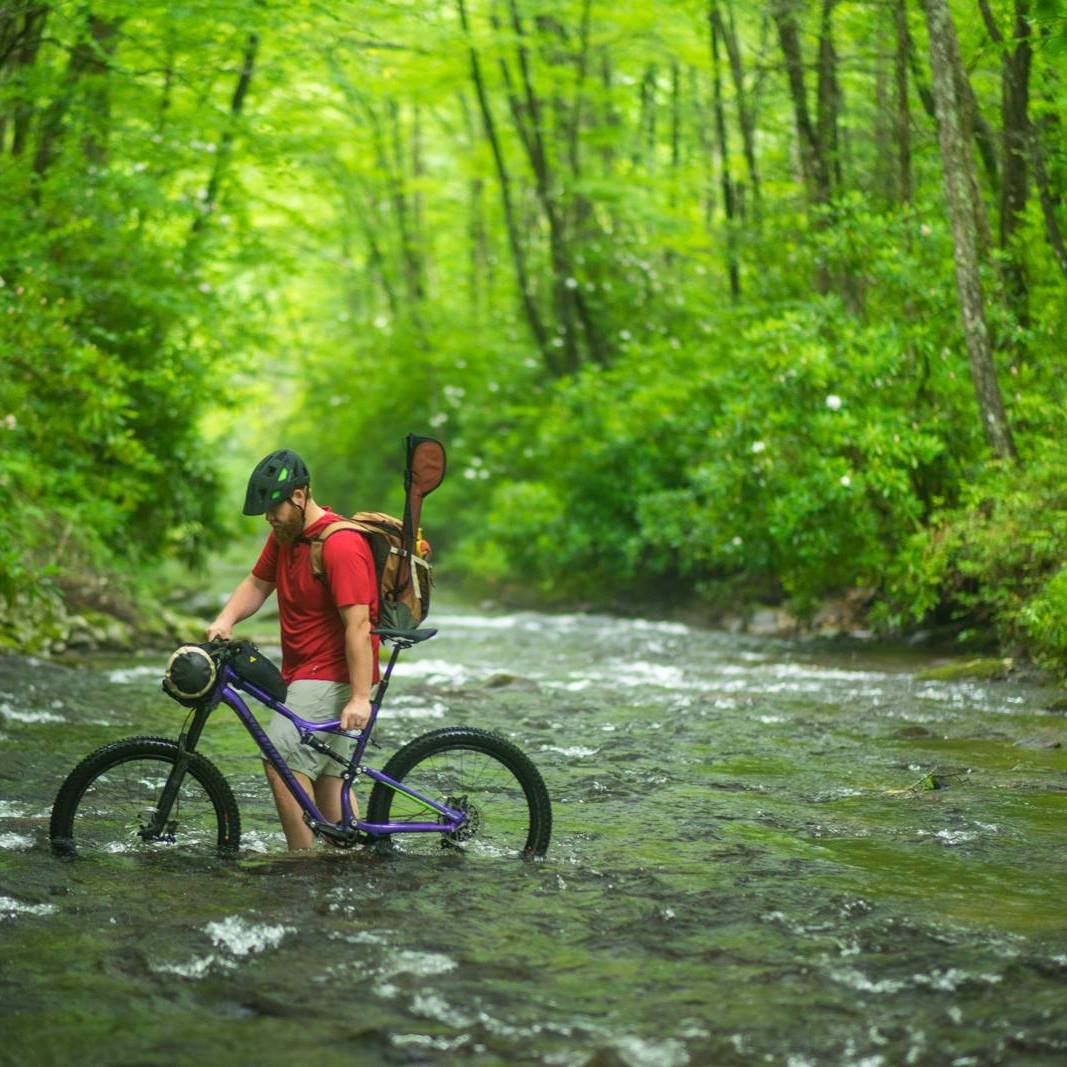
The Adventure
On the morning of the trip, I met Aaron at an Ingles parking lot in the speed trap town of Mills River, N.C. to procure essential provisions: trail mix, local craft beer, and vacuum-sealed salmon.
Then our talk turned to the weather. Rain, it seemed, was all but certain in the forecast. Such conditions come with the territory in the section of Pisgah we were headed for, which routinely receives as much as ninety inches of annual rainfall. The forecast did little to dampen our excitement.
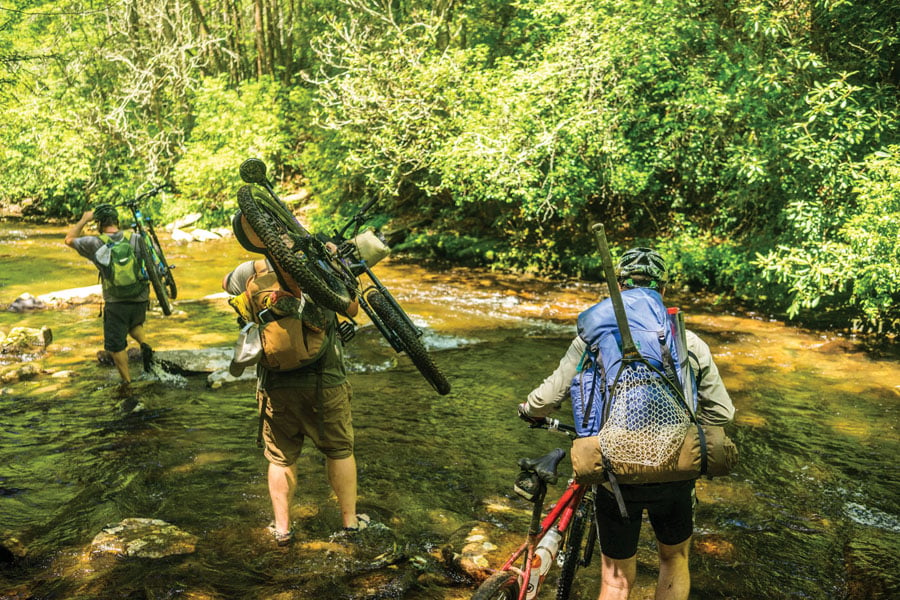
We secured our bikes—full suspension Specialized outfits provided by Motion Makers Bicycle Shop in Asheville—and began our caravan toward the South Mills River Recreation Area.
We arrived at the trailhead at the Wolf Ford Gauging Station just off of Forest Service Road 476, and we began loading our bikes with camping equipment and fly fishing gear.
When fishing the South Mills, Aaron relied heavily on a traditional Japanese fishing method known as tenkara. First popularized in the United States by Daniel Galhardo, who founded Tenkara USA and is an avid bikefisher in his own right, the tenkara style is tailor made for the trout streams of Southern Appalachia. It puts the focus on simplicity by taking the reel completely out of the fly fishing equation and allows for easier casting on tight-quartered, rhodo-choked streams.
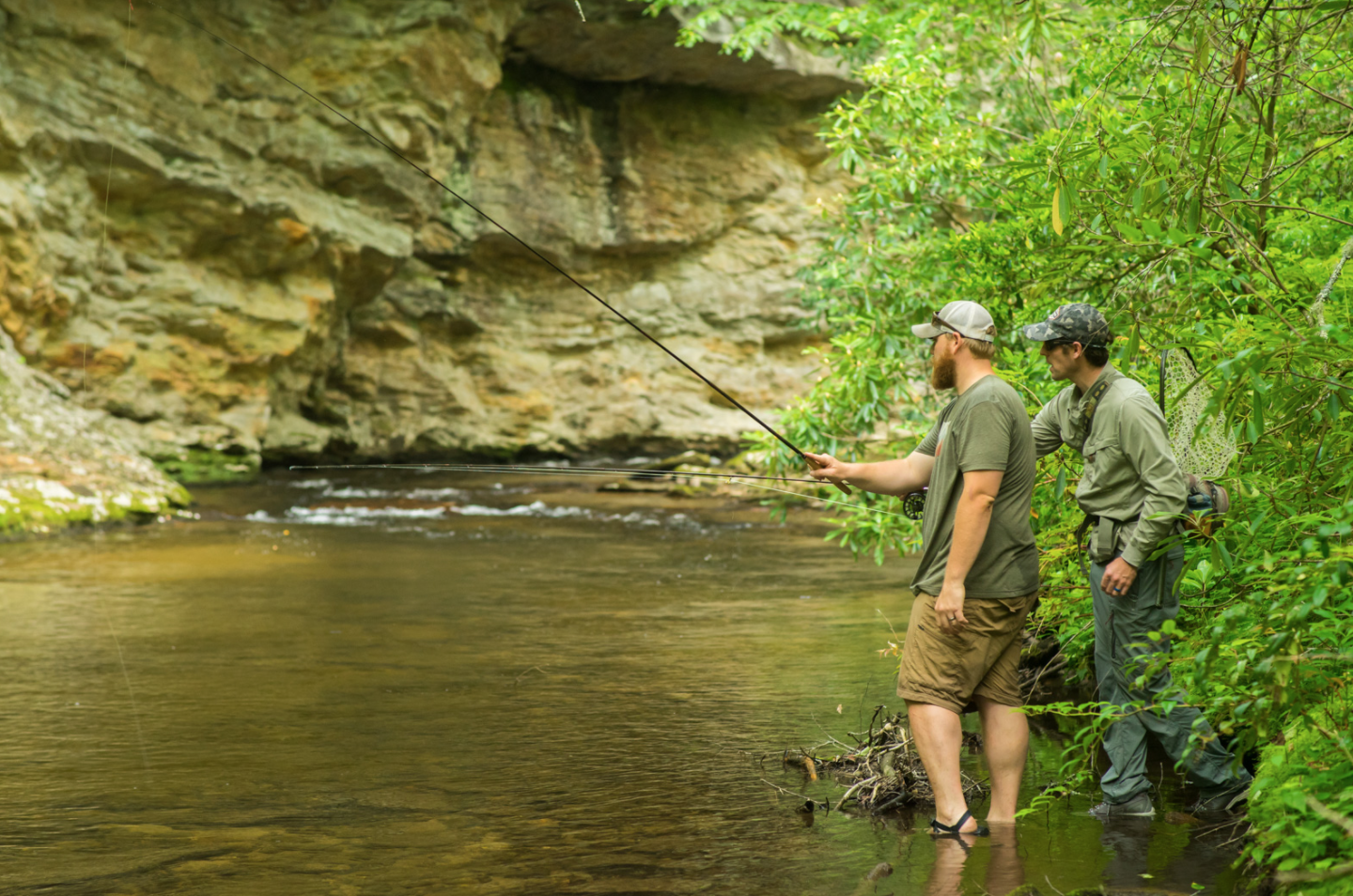 Once the tenkara rods were securely strapped to Aaron’s pack, we hit the trail and begin following the course of the clear-flowing, rhododendron cloaked South Mills.
Once the tenkara rods were securely strapped to Aaron’s pack, we hit the trail and begin following the course of the clear-flowing, rhododendron cloaked South Mills.
“Biking is the only way I go back in here,” Aaron tells me as we negotiate typical Pisgah singletrack, complete with rock ledges and downed logs. “It’s the perfect combination of two of my favorite adventures, and it affords me access to spots that other anglers seldom take the time to reach.”
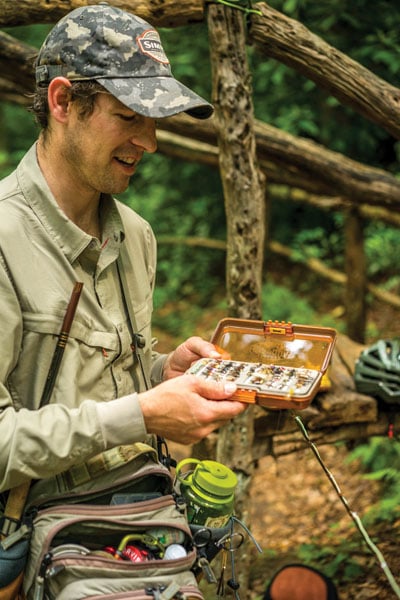
About three miles in, we arrived at a suspension bridge where the South Mills River Trail meets Squirrel Gap. It looked like a tantalizing place to wet a line, but our attention was diverted by the late arrival of our cohort, BRO digital publisher Dusty Allison. From the other side of the bridge, Dusty was wheeling up with a riding partner he found somewhere along the way.
As fate would have it, that riding partner turned out to be the bass player for the Infamous Stringdusters, Travis Book. Unlike the rest of his bandmates, who call the state of Colorado home, Travis lives in the nearby town of Brevard, North Carolina, and aside from being a heralded musician, he’s known around those parts as one hell of a mountain biker.
We chatted for awhile with Travis, who had just come off a road stint and a show at Red Rocks with Ryan Adams. Then he pointed his bike in the direction of Squirrel Gap and took off on what Strava would later tell me was a thirty-plus mile ride.
Slightly star-struck, we pedaled onward in the opposite direction, where dog-hobble undergrowth, multiple river crossings and—we hoped—copious wild trout would await.
[nextpage title=”Read on!”]
Finding Copperas Rock
After a strenuous six-mile ride made even more difficult by heavy packs and a healthy dose of skin-shredding doghobble, we finally arrive at our intended destination— Copperas Rock.
This imposing rock feature soared high above the west side side of the South Mills to the tune of some seventy feet while a plentiful population of wild trout danced in the gin-clear pools below.
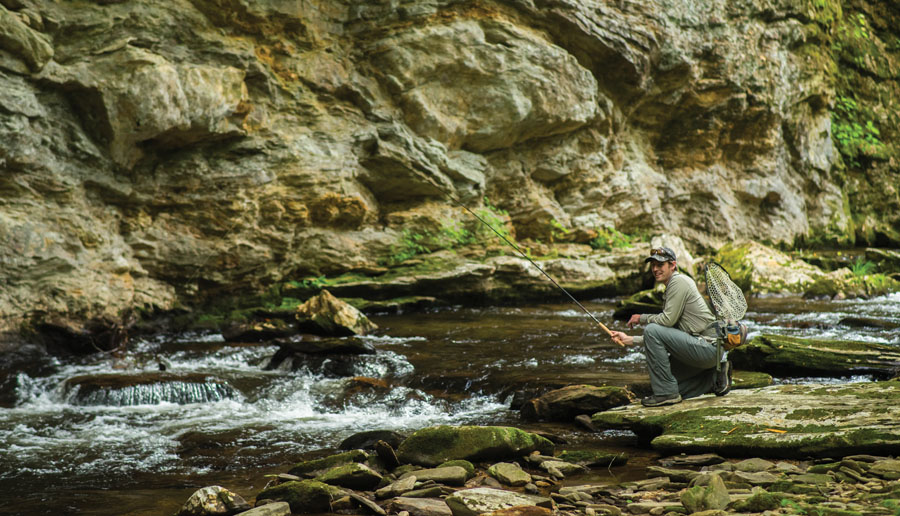
Dusty was the first of our group to wet a line. Like Aaron, he’s a devotee of the trustee tenkara method, but since his rod had been compromised by an overhanging limb during the grueling ride in, Aaron set him up with his 12-foot IWANA rod from Tenkara USA, complete with the deadly combination of a size 12 Parachute Adams and Frenchie nymph dropper.
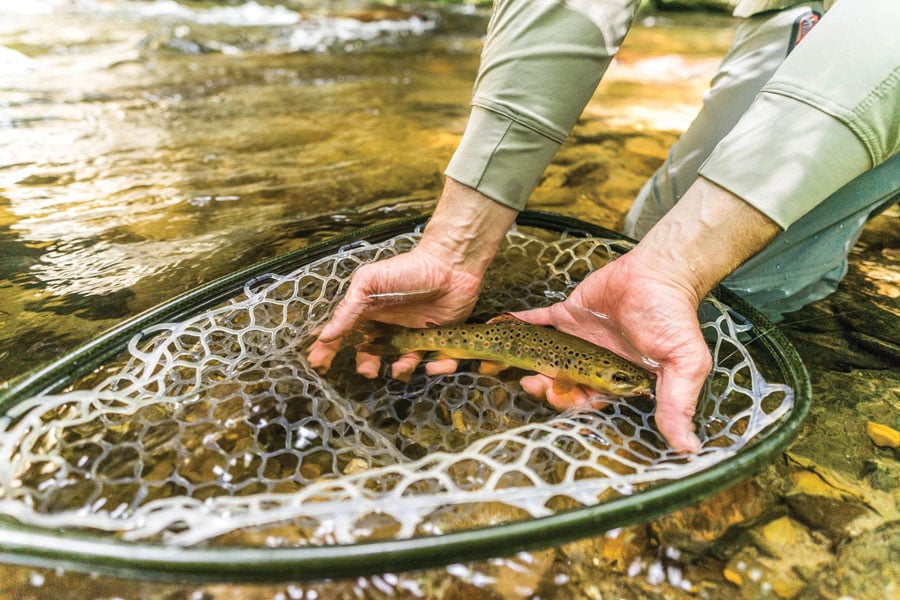
Within a matter of minutes, Dusty had hooked the first wild Brown Trout of the trip. The trout, which sported colors more vibrant than those I’d seen on more familiar delayed harvest haunts, was ultimately enticed by the Frenchie, attacking it with a type of aggression unique to brown trout living in remote, wild places. Dusty’s fish set the tone for another 24 hours of stellar fly fishing, top notch mountain biking, and priceless camaraderie in one of North Carolina’s finest national forests.
Looking to organize a bikefishing excursion of your own? Consider one or more of these ideal destinations.
Virginia
Whitetop Laurel Creek (accessed VIA the Virginia Creeper Trail)
If you’re looking for a more moderate bikefishing adventure, you’d be hard pressed to find a better destination than Whitetop Laurel Creek via the Virginia Creeper Trail. Stretching for 34 miles through the heart of Southwest Virginia, just outside the Appalachian Trail town of Damascus, the Virginia Creeper Trail has long been famous among bikers, but it also offers quick and easy access to Whitetop Laurel, one of Virginia’s best trout streams.
West Virginia
New River Gorge
The New River Gorge National River is home to some of the best fly fishing East of the Rockies, and the trail systems found along its banks offer unrivaled opportunity for bike-in angling. Try the Glade Creek Trail, which provides streamside access to 5.6 miles of the popular Glade Creek trout stream. For more info visit nps.gov/neri
North Carolina
Great Smoky Mountains National Park (North Carolina side)
Typically, mountain biking is not an option within the boundaries of a national park, but the Deep Creek area on the North Carolina side of Great Smoky Mountains National Park is a rare exception. Both Deep Creek and Indian Creek are accessible by way of moderate, stream-side trails where mountain biking is permitted. Set up a base camp at the Deep Creek Camping Area and enjoy these two pristine Smoky Mountain streams in conjunction with a mellow mountain biking journey. For more info visit greatsmokies.com/deepcreek
North Mills River Area
Like its South Mills counterpart, the North Mills River Recreation Area of Pisgah National Forest offers ample bikefishing opportunities. Set up a base camp at the Mills River campground before setting off to explore the North Mills and its multiple tributaries such as Big Creek, Middle Fork, Fletcher Creek, and Spencer Branch.
Georgia
Mountaintown Creek
According to Andrew Gates of the Mulberry Gap Mountain Bike Getaway in Ellijay, there are few trails in the area that combine biking and fishing better than the Mountaintown Creek Trail. “Mountaintown Creek trail is a must do for fly fishing as well as biking,” Gates says. “It is one of the most remote and beautiful trails in our area, and it has a thriving population of native trout.”
